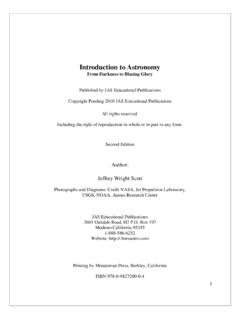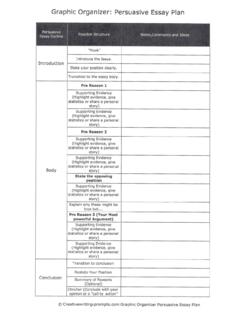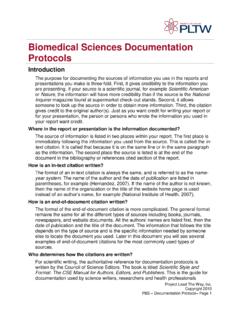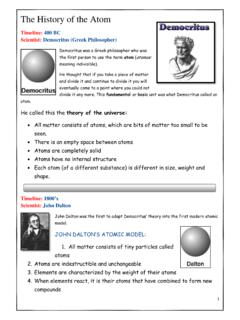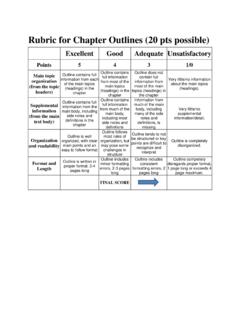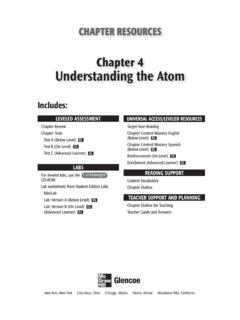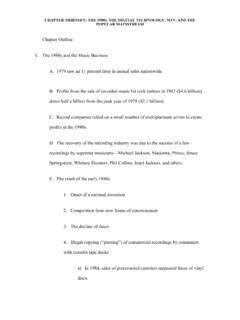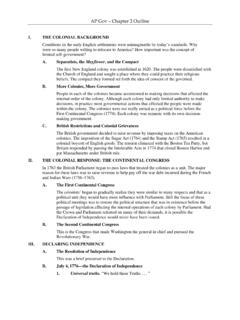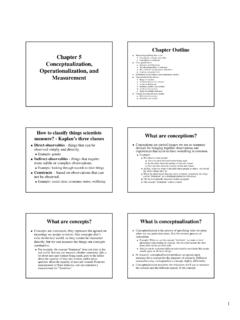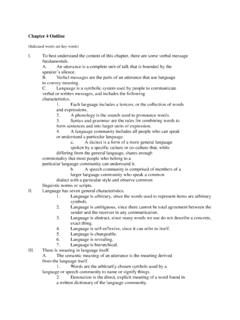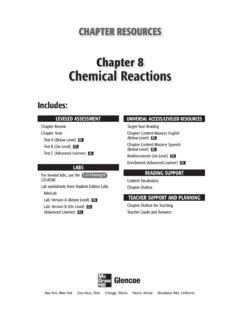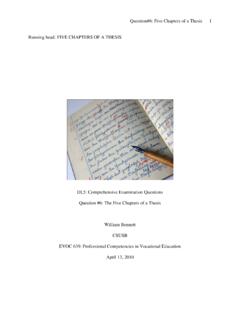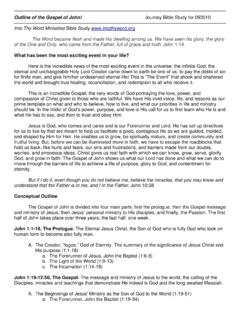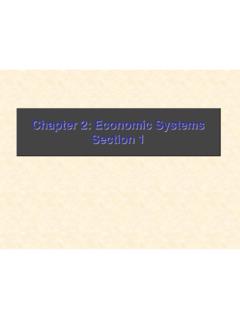Transcription of American Pageant - Chapter Outline – Chapter 24 Chapter 24 ...
1 History American Pageant - Chapter Outline Chapter 24 The following is taken from website ( , 2008). It is to be used as a supplemental resource to your reading in this AP class, NOT as a substitution. Chapter 24 - Industry Comes of Age I. The Iron Colt Becomes an Iron Horse A. After the Civil War, railroad production grew enormously, from 35,000 mi. of track laid in 1865 to a whopping 192,556 mi. of track laid in 1900. 1. Congress gave land to railroad companies totally 155,504,994 acres. 2. For railroad routes, companies were allowed alternate mile-square sections in checkerboard fashion, but until companies determined which part of the land was the best to use for railroad building, all of the land was withheld from all other users.
2 A. Grover Cleveland stopped this in 1887. B. Railroads gave land their value; towns where railroads ran became sprawling cities while those skipped by railroads sank into ghost towns, so, obviously, towns wanted railroads in them. II. Spanning the Continent with Rails A. Deadlock over where to build a transcontinental railroad was broken after the South seceded, and in 1862, Congress commissioned the Union Pacific Railroad to begin westward from Omaha, Nebraska, to gold-rich California. 1. The company received huge sums of money and land to build its tracks, but corruption also plagued it, as the insiders of the Credit Mobilier reaped $23 million in profits. 2. Many Irishmen, who might lay as much as 10 miles a day, laid the tracks.
3 3. When Indians attacked while trying to save their land, the Irish dropped their picks and seized their rifles, and scores of workers and Indians died during construction. B. Over in California, the Central Pacific Railroad was in charge of extending the railroad eastward, and it was backed by the Big Four: including Leland Stanford, the ex-governor of California who had useful political connections, and Collis P. Huntington, an adept lobbyist. 1. The Central Pacific used Chinese workers, and received the same incentives as the Union Pacific, but it had to drill through the hard rock of the Sierra Nevada. C. In 1869, the transcontinental rail line was completed at Promontory Point near Ogden, Utah; in all, the Union Pacific built 1,086 mi.
4 Of track, compared to 689 mi. by the Central Pacific. III. Binding the Country with Railroad Ties A. Before 1900, four other transcontinental railroads were built: Mr. M. A. Rivera American Pageant Chapter 24 Outline Page 1 of 8 History 1. The Northern Pacific Railroad stretched from Lake Superior to the Puget Sound and was finished in 1883. 2. The Atchison, Topeka, and Santa Fe stretched through the Southwest deserts and was completed the following year, in 1884. 3. The Southern Pacific (completed in 1884) went from New Orleans to San Francisco. 4. The Great Northern ran from Duluth to Seattle and was the creation of James J. Hill, probably the greatest railroad builder of all. B. However, many pioneers over-invested on land, and the banks that supported them often failed and went bankrupt when the land wasn t worth as much as initially thought.
5 IV. Railroad Consolidation and Mechanization A. Older eastern railroads, like the New York Central, headed by Cornelius Vanderbilt, often financed the successful western railroads. B. Advancements in railroads included the steel rail, which was stronger and more enduring than the iron rail, the Westinghouse air brake which increased safety, the Pullman Palace Cars which were luxurious passenger cars, and telegraphs, double-racking, and block signals. 1. Nevertheless, train accidents were common, as well as death. V. Revolution by Railways A. Railroads stitched the nation together, generated a huge market and lots of jobs, helped the rapid industrialization of America, and stimulated mining and agriculture in the West by bringing people and supplies to and from the areas where such work occurred.
6 B. Railroads helped people settle in the previously harsh Great Plains. C. Due to railroads, the creation of four national time zones occurred on November 18, 1883, instead of each city having its own time zone (that was confusing to railroad operators). D. Railroads were also the makers of millionaires and the millionaire class. VI. Wrongdoing in Railroading A. Railroads were not without corruption, as shown by the Credit Mobilier scandal. B. Jay Gould made millions embezzling stocks from the Erie, Kansas Pacific, the Union Pacific, and the Texas and Pacific railroad companies. C. One method of cheap moneymaking was called stock watering, in which railroad companies grossly over-inflated the worth of their stock and sold them at huge profits.
7 D. Railroad owners abused the public, bribed judges and legislatures, employed arm-twisting lobbyists, elected their own to political office, gave rebates (which helped the wealthy but not the poor), and used free passes to gain favor in the press. Mr. M. A. Rivera American Pageant Chapter 24 Outline Page 2 of 8 History E. As time passed, though, railroad giants entered into defensive alliances to show profits, and began the first of what would be called trusts, although at that time they were called pools. A pool (AKA, a cartel ) is a group of supposed competitors who agree to work together, usually to set prices. VII. Government Bridles the Iron Horse A. People were aware of such injustice, but were slow to combat it.
8 B. The Grange was formed by farmers to combat such corruption, and many state efforts to stop the railroad monopoly occurred, but they were stopped when the Supreme Court issued its ruling in the Wabash case, in which it ruled that states could not regulate interstate commerce, such as trains. C. The Interstate Commerce Act, passed in 1887, banned rebates and pools and required the railroads to publish their rates openly (so as not to cheat customers), and also forbade unfair discrimination against shippers and banned charging more for a short haul than for a long one. 1. It also set up the Interstate Commerce Commission (ICC) to enforce this. D. The act was not a victory against corporate wealth, as people like Richard Olney, a shrewd corporate lawyer, noted that they could use the act to their advantage, but it did represent the first attempt by Congress to regulate businesses for society s interest.
9 VIII. Miracles of Mechanization A. In 1860, the was the 4th largest manufacturer in the world, but by 1894, it was #1, why? 1. Now-abundant liquid capital. 2. Fully exploited natural resources (like coal, oil, and iron, the iron came from the Minnesota-Lake Superior region which yielded the rich iron deposits of the Mesabi Range). 3. Massive immigration made labor cheap. 4. American ingenuity played a vital role, as such inventions like mass production (from Eli Whitney) were being refined and perfected. a. Popular inventions included the cash register, the stock ticker, the typewriter, the refrigerator car, the electric dynamo, and the electric railway, which displaced animal-drawn cars. B. In 1876, Alexander Graham Bell invented the telephone and a new age was launched.
10 C. Thomas Edison, the Wizard of Menlo Park, was the most versatile inventor, who, while best known for his electric light bulb, also cranked out scores of other inventions. IX. The Trust Titan Emerges A. Industry giants used various ways to eliminate competition and maximize profits. Mr. M. A. Rivera American Pageant Chapter 24 Outline Page 3 of 8 History 1. Andrew Carnegie used a method called vertical integration, which meant that he bought out and controlled all aspects of an industry (in his case, he mined the iron, transported it, refined it, and turned it into steel, controlling all parts of the process). 2. John D. Rockefeller, master of horizontal integration, simply allied with or bought out competitors to monopolize a given market.
